Although the peak of the pandemic seems firmly in the rear-view mirror, a “new normal” has not yet truly emerged, including—and perhaps especially—in the way we work. Even as some prominent CEOs have declared the end of remote work and demanded that their employees return to a centralized office, the headlines are still filled with stories of empty downtown office buildings. Fears of a recession persist, yet the labor market remains historically strong.
Amid such mixed signals and unstable terrain, companies are bracing for continued upheaval and are preparing for a wide range of possibilities. Instead of falling back on traditional solutions, organizations must rely on experimentation and knowledge-sharing to chart a productive path forward. To aid in this effort, CompTIA's Workforce and Learning Trends examines how human resources (HR) and learning and development (L&D) professionals are thinking about these challenges while simultaneously working to move their organizations forward on many fronts.
The economy stands at the forefront of many organizations' concerns. Almost 80% of survey respondents expect that economic conditions will moderately or significantly impact their company's human resources priorities on some level in 2023.
Employees are also feeling the stress. According to a recent iCIMS survey, nearly 80% of workers do not feel fully secure professionally or financially. Some segments of workers are now less likely to quit without a new job lined up than they were one year ago. However, that has not dampened the desire for new or better employment opportunities, and approximately 30% of the workforce continues to actively explore career changes, according to CompTIA's latest Job Seeker Trends research.
Despite the pendulum swings of sentiment, the long-term trends in the labor market continue to point to talent constraints in many occupation categories. A majority of HR professionals in CompTIA's survey expect their organizations will maintain their current pace of hiring in the first half of 2023. At the time of reporting, the national unemployment rate hovered at a historically low 3.6%, while the unemployment rate for technology professionals stood at 2.2%, signaling a very tight labor market for tech talent.

Hiring continues to be driven by the pursuit of cutting-edge skills that can help organizations gain or maintain their competitive edge. In terms of staffing changes anticipated in the first half of 2023, the overwhelming majority of respondents indicated that they were planning to hire to fill new positions or meet the demand for new skills—rather than fill vacated positions or tighten their workforce through layoffs or hiring freezes.
Given sustained economic concerns, paired with an unusually strong labor market, many businesses are turning to their existing resources to find or develop the desired skillsets, rather than exclusively trying to attract new external talent. Although skills remain a core focus, flexibility is the new watchword. Employers and employees alike are striving to maximize untapped opportunities within their present situations. Business leaders are pursuing new ways to take stock of their organizations’ existing skills and are expressing more openness to unconventional, shorter-term arrangements that enable employees to contribute across the organization. Employees, in turn, seem more willing to remain within their current situation if they feel like opportunities for advancement are available.
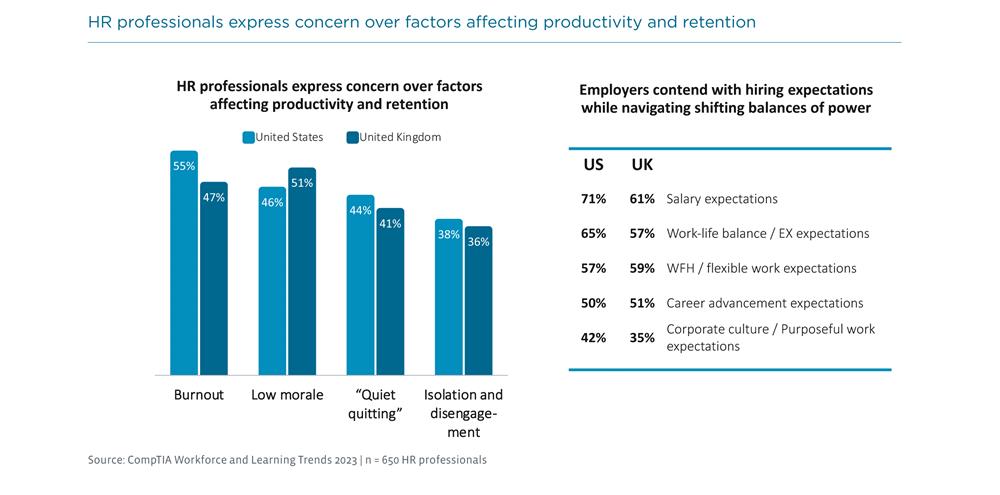
Talent mobility approaches grow in scope and importance
To maintain a competitive advantage in a post-pandemic era marked by rapid change and innovation, companies must be able to develop and then deploy their existing resources effectively, quickly, and responsively. Learning and development programs, aimed at both upskilling and reskilling workers, will be essential—but not sufficient in and of themselves—for success. Companies will also need to maintain a comprehensive and real-time inventory of their current skills and shift those skills throughout the organization to match current needs.
Even before the pandemic, projecting which skills would be valuable over a three-to-five-year horizon was difficult, given the rate of technological change and evolution. But more recently, as the structure and location of work have changed dramatically, such projections have become even more challenging. The World Economic Forum estimates that within the next five years, up to 50% of all employees will require some level of reskilling to perform their roles effectively, and nearly 100 million new roles will be created. A five-year development plan for either an organization or an individual can seem daunting in this context.
The breakneck rate of skills turnover is likely a prime motivator for companies’ adoption and expansion of talent mobility programs. In total, three-quarters of the respondents to the CompTIA survey reported the existence of either a formal or informal talent mobility program within their organization, and 75% report that their organization plans to increase their program’s scope and their emphasis on talent mobility programs and policies.

When an organization has a well-developed, far-reaching, and successful talent mobility program, it can adapt to changing environments, adroitly identify needed skills, and then deploy resources quickly and effectively across teams, divisions, or even entities. These multi-faceted programs nurture internal talent and leverage the underutilized skills of an existing workforce rather than relying on new hires to fill skills gaps, offering powerful benefits, especially at a time when many are being tasked to do more with less.
Employers can use talent mobility programs to improve outcomes by engaging and developing their current talent. From employees’ perspectives, the moment of the “great resignation” may be fading, and they too are more drawn to stability and certainty than they were even a year ago. A recent survey found that of people who left their jobs due to feeling unhappy or unfulfilled, 54% later regretted doing so. This indicates an opening for employers to retain more workers if they can create more advancement opportunities and make those opportunities more visible and accessible across the organization. In fact, LinkedIn found that 41% of employees will stay longer at a company that offers high internal mobility versus companies with low internal hiring. Strong talent mobility programs, therefore, can motivate employees who are already a culture fit to stay with an organization and, therefore, help a company avoid unnecessary hiring and onboarding costs.
Talent mobility programs also make it easier to move current employees within an organization. These employees can begin adding value from their first day on a new job because they don’t require the same start-up time as a new hire. Plus, when employees move across an organization, they can bring deep expertise from one part of the business to another, generating new insights and opportunities. But to accomplish this, companies must create reward systems, relevant development tools, and coaching and mentoring opportunities to facilitate this exchange of knowledge and experience.
That is why it is so important for talent mobility programs to not only focus on the organization’s strategic goals, but also to create opportunities for employees across the company to pursue their own professional interests. Business leaders in our survey seemed to appreciate this goal. A majority indicated that their talent mobility programs were primarily driven by the desire to empower employees to actively manage their careers. Only 31% of respondents indicated that their talent mobility programs were the product of necessity when external searches failed.
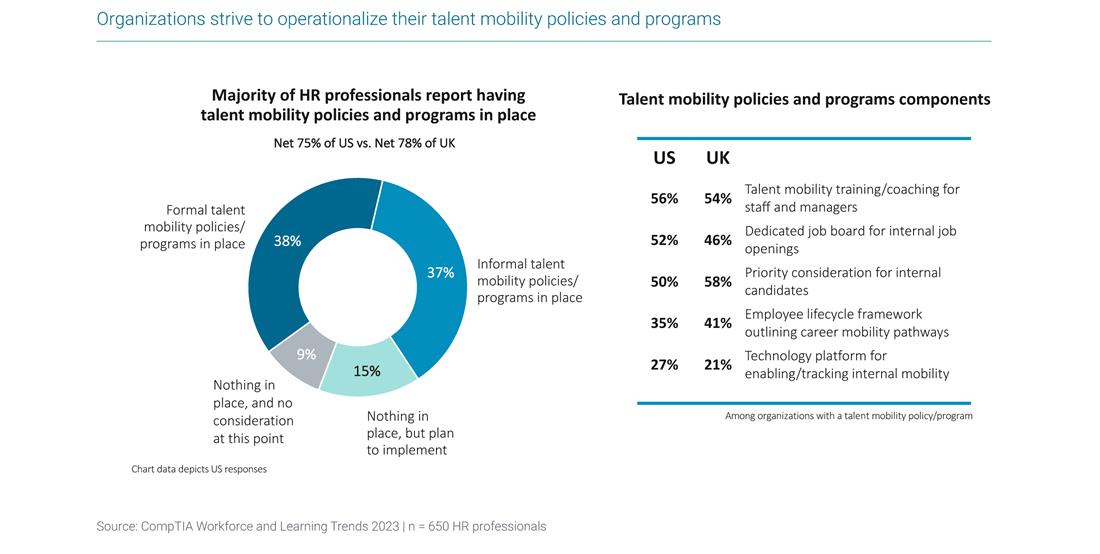
Yet, there may be a gap between what employers think they are providing versus how employees perceive those efforts. According to iCIMS, 70% of workers report not knowing how to progress in their careers, and more than half think it’s difficult to find and apply to open jobs internally. Such beliefs impede retention. Workers recognize that changing roles is necessary to upgrade their skills, raise their income, and demonstrate a track record of evolving and relevant experience. If they do not feel they can change roles internally, they will be driven to look elsewhere.
Talent mobility programs also must reckon with employer and employees’ increasing prioritization of experiential learning and hands-on, performance-based training. Simply moving employees to new projects and teams will not generate meaningful and successful talent mobility within an organization. Individuals are unlikely to do well in new roles without supplemental training and mentoring so that they can rapidly adapt to their new assignments. Flexible work arrangements also require substantial logistical coordination, which means talent mobility programs must provide a holistic, but also deep, view of an organization and the individuals within it. This not only raises the stakes of such programs, but it also places more responsibility on L&D and HR professionals.
CompTIA believes that talent mobility programs can—and should—extend beyond a single corporation’s efforts. We research, analyze, and advocate for best-in-class training that can empower a broad range of workers to contribute to—and benefit from—the opportunities available across the full breadth of the information technology (IT) workforce. The CompTIA Apprenticeships for Technology Program, for example, offers businesses the opportunity to upskill and reskill workers while connecting people to promising careers in IT. This program uses a competence-driven skills attainment model to help interested workers transition from a job to a fulfilling career pathway. In addition to efforts like the Apprenticeship Program, CompTIA routinely partners with large organizations and local governments to develop scalable training programs that can be implemented for communities at large.
T-shaped skills models remain integral for future-proofing careers
Although the phrase “T-shaped skills” was coined over 30 years ago, it has recently gained more popularity in the professional development industry because it provides a compelling visualization of the unique combination of depth and breadth of skills that can lead to success in today’s workplace. In the CompTIA Workforce survey, 84% of respondents indicated that they use a T-shaped skills model in some capacity to guide talent management. The “T-shaped model” signifies an employee with significant understanding of a particular field, as well as a wide range of cross-discipline competencies. In this formulation, the vertical bar of the “T” represents the in-depth knowledge of the specialized field, and the horizontal bar of the “T” represents capabilities in a broad range of related skills. An employee with T-shaped skills is particularly valuable today when flexibility is so prized; they can draw on their technical knowledge and apply it to areas of expertise and business segments other than their own. This powerful combination can help future-proof an organization and boost its competitiveness.
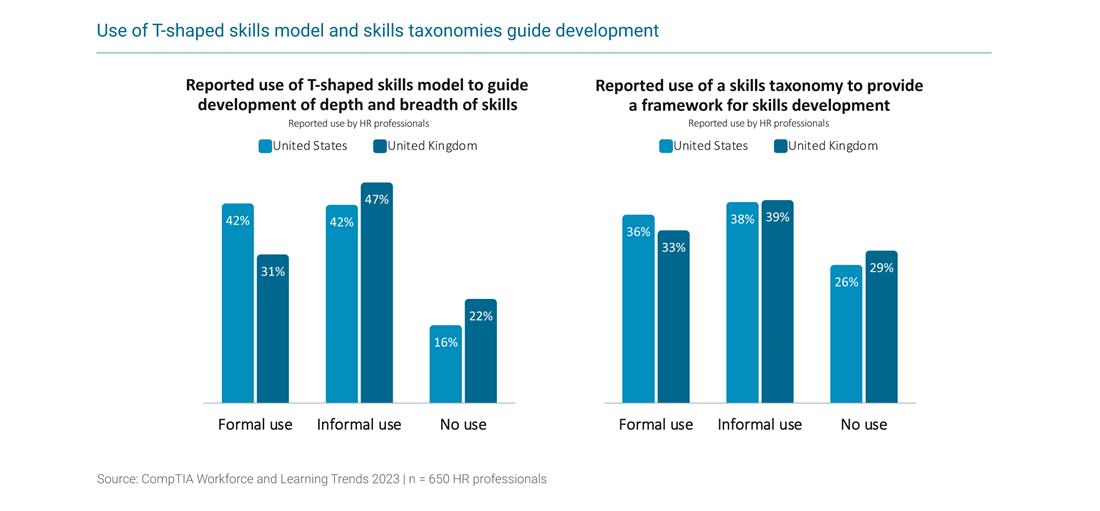
Although similar, the T-shaped model connotes some important distinctions from the “specialist versus generalist” formulation or the recent emphasis on soft skills, also referred to as durable skills.

Developing T-shaped employees arguably requires more professional development and continuing education than more traditional skills models do. Mid-career professionals may need as much, or more, training than their lower-level counterparts. That is because to sustain both axes of the “T,” employees need to stay up to date on the technical skills that are central to their core function, but they also need to develop broader capabilities, including creativity, collaboration, and communication skills. A senior business leader, for example, should understand their organization’s operations and strategic goals, as well as the larger industry context.
Such challenges help explain why HR professionals are increasingly turning to skills taxonomies—a strategy employed by 74% of the respondents in the CompTIA survey. Skills taxonomies classify and track the capabilities within an organization and can, therefore, amplify and refine talent mobility efforts. They can also help organizations create training opportunities that enable employees to learn complementary skills. Employees can also benefit from skills taxonomies because they can see what skills they’ve mastered and identify which learning opportunities will help them pursue their objectives. Business leaders can also evaluate the ways skills are learned in their organization and track how those competencies become deeper and broader over time.
Despite the widespread adoption of skills taxonomies, only 36% of survey respondents use a formal tool to do so. One explanation for this is that formal tools require both money and time to create and maintain. But an added difficulty is the challenge of tracking skills acquisition. Employees often learn via organic, unpredictable, and yet remarkably powerful arrangements. An employee at a call center learns to remain calm with difficult customers by overhearing a veteran supervisor day after day. An IT help desk worker improves her coding skills by asking questions from the programmer sitting next to her. Even though L&D and HR professionals recognize the considerable value of these informal learning opportunities, such arrangements are difficult to incorporate systematically into a structured tool.
Algorithms and platforms exert greater influence over talent development
The concept of human resources technology – commonly referred to as HR tech—continues to evolve. It was not too long ago when HR tech centered around Microsoft Word docs, spreadsheets, and a couple of siloed applications. Today, HR tech encompasses many interconnected systems, spanning software, hardware, platforms, data, and cybersecurity, with the prevailing goal of orchestrating digital and people transformation.
Despite the imprecise market sizing estimates of the multi-billion-dollar HR tech space due to definitional challenges, most projections depict a rapidly growing market fueled by existing players and new market entrants. According to Pitchbook, a capital markets research firm under the parent company Morningstar, VC investment in HR tech startups in 2021 soared by over 250%, year-over-year. Even with the recent cooling of early-stage investments, HR tech remains an attractive market for deal flow and disruption.
CompTIA’s survey of HR professionals confirms this outlook. A majority of organizations reported plans to upgrade or adopt new HR tech in the year ahead. Such a change typically starts with core systems and platforms, designated as HRIS, HRMS, or HCM, where two-thirds of organizations have new or expanded investments on their technology roadmap. As expected, investment activity skews towards larger organizations, but it is reasonable to infer that organizations of all sizes are in some stage of adoption or evaluation.
The most interesting investment from the perspective of “what’s next” is in the emerging areas of talent development. From the survey data, three of the top four new investments in platforms and systems are in areas that focus on developing and deploying talent.
- Learning and training platforms
- Talent mobility and talent marketplace platforms
- Skills inventory, talent intelligence, and career pathways platforms
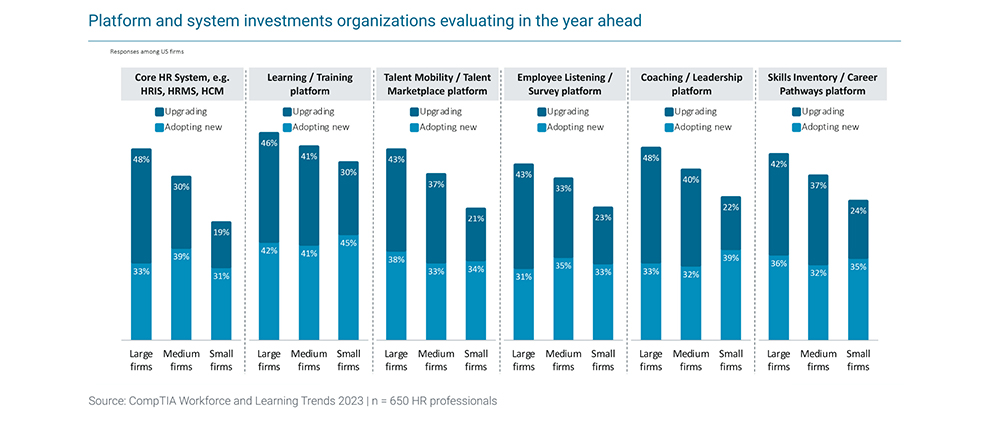
The old adage “it’s not about the technology” arguably rings truer than ever with regards to HR tech. Advances in technology are undoubtedly important, especially with integrated solutions that prioritize user experience. Achieving desired outcomes, however, inevitably requires much more than just a quick technological fix. For example, the most sophisticated training and development platforms will likely underperform if the learning content, implementation, staff support, and executive leadership commitment fall short.
Despite indications of the growing strategic importance of the HR function, many organizations continue to see room for improvement in fine-tuning processes and policies across CHRO, CIO, CFO, and other C-suite power centers.
Do the already high strategic stakes of HR get even higher with the emergence of artificial intelligence (AI) and the prospect of an algorithmic-driven organization? One school of thought leans into historical context, asserting that the wave after wave of technological innovation is more evolutionary and gradual than revolutionary and radical. The counterpoint, of course, rests on the “Is this time different?” question.
Based on the CompTIA survey data, most HR professionals expect some degree of impact (net 72% among US respondents), but like most, others grapple with the timing and magnitude of impact.

The early uses cases of generative AI, most notably OpenAI’s ChatGPT, provide a glimpse at the potential. Imagine understaffed HR departments using a generative AI platform to write job descriptions, employee handbooks, conflict of interest disclosures, and the list goes on. But generative AI tools also open up the possibility that higher level tasks, such as comprehensive employee engagement analysis, salary reviews, interactive coaching, or candidate interviews, can also become automated. These uses are not merely theoretical; they are happening today.
When ChatGPT itself was asked about potential uses of AI in human resources – a clever approach taken by the HR Exchange Network—the system returned the following categories of functions:
- Recruiting and hiring
- Employee onboarding
- Employee engagement
- Performance evaluation
- Training and development
- Compliance and policy
- HR data management
- Employee assistance
- Diversity and inclusion
While the accompanying chart shows only 10% of HR professionals reporting an initial negative perception of AI, the larger 52% in the “to-be-determined” camp clearly has questions and concerns. The concept of AI bias has been around for many years. Examples of hiring platforms trained on biased data that then produce algorithmic-biased results in candidate selection make the headlines on an all-too-frequent basis. In addition, there are many concerns over accuracy (such as, whether AI can really know what it doesn’t know), as well as privacy and cost. It is still early in the generative AI trend cycle, and it will take time and thoughtful refinements before the true impact becomes clear.
Organizations strive to maintain DEIB and ESG momentum
Diversity, Equity, Inclusion, and Belonging (DEIB) continues to be top of mind for HR professionals. In CompTIA’s 2021 Workforce and Learning Trends Survey, more than half of HR professionals expected their organizations to pursue new initiatives related to DEIB in the year ahead. Two years later, the impacts of these initiatives are beginning to emerge—52% reported their organization’s status with DEIB efforts was regaining or generating momentum. Although there’s certainly room for improvement, there is also hope on the horizon: 35% say their DEIB efforts are moving to the next level.
The principles of the Environment, Social, and Governance (ESG) framework have also emerged as a major area of focus, and 83% of respondents reported having some ESG programs and policies in place. As with DEIB efforts, the data suggests movement on the ESG front, but opportunity for improvement remains. While 57% reported their organization’s ESG efforts as regaining or generating momentum, 29% indicated that they are taking their ESG efforts to the next level.
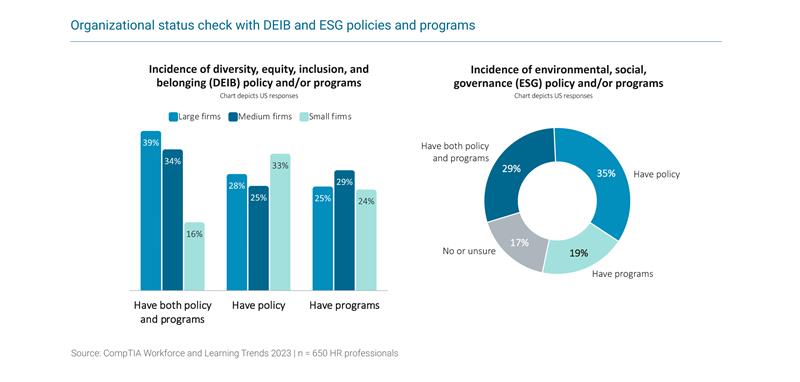
Companies are facing some significant challenges as they attempt to achieve or maintain this momentum, though. Identifying the right priorities, goals, and metrics of success tops the list; 44% of respondents indicated that this is a challenge. A sizable number, 41%, point to general resistance to change and to budget constraints as the next two challenges, followed by execution (40%), commitment from senior leadership and boards (37%), and bias—both conscious and unconscious (28%).
These results are reflected in other research. Evelyn R. Carter, a social psychologist, and Natalie Johnson, cofounder and managing director of Paradigm, indicated that while 60% of their study’s participants reported having DEI strategies in place, these strategies didn’t “always focus on the right goals or accountability partners.” Only 28% of the companies held C-suite executives accountable for the progress of a DEI strategy, for instance. The study also found that it was difficult for organizations to collect and analyze the right data to guide and assess their efforts.
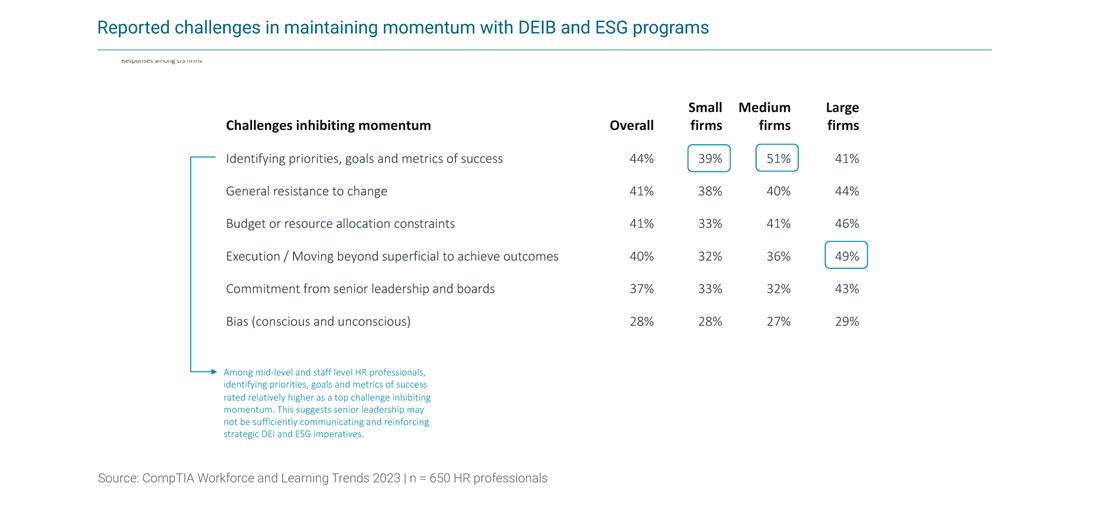
Other research on ESG progress reflects similar challenges. While more than 90% of S&P 500 companies now publish ESG reports as they’re mandated to do, significant barriers remain. It is difficult to identify which metrics actually measure the effectiveness of ESG programs. In addition, these metrics must be accurately tracked and then broadly reported so that apples-to-apples comparisons can be made. Without this kind of consistent and revealing data, investors, consumers, potential employees, and other key stakeholders are left without critical, actionable insights, according to McKinsey.
Despite these obstacles, our research reveals that DEIB has been an area of interest for at least two years now, and ESG is quickly becoming a focus—even within companies that are not mandated to report on these measures. This demonstrates a concerted effort that is clearly gaining momentum. This year’s responses surrounding both DEIB and ESG means these efforts will likely make continued progress in 2024.
Talent marketplaces add new dimension to workforce flexibility
Organizations increasingly value the idea of workplace flexibility, but facilitating and maintaining these flexible work arrangements create significant challenges. Robust talent marketplaces have the potential to transform how work is assigned and to revolutionize talent mobility programs. The best-known talent marketplace platforms are the large-scale, broad-based freelancing sites, such as Upwork or freelancer.com, where employers can post jobs and workers can apply for positions that match their interests. In this year’s Workforce and Learning Trends survey, 68% of respondents indicated their companies use these external, freelance marketplaces frequently or occasionally. The most often cited motivations for consulting these tools were the need for a specific skillset, followed by the potential cost advantages of using freelance employees.
The stigma that sometimes surrounded these talent platforms—and freelance work more generally—has lifted in recent years. When these platforms first came online, freelancers were often perceived as “stuck” on such sites, resorting to them as stopgap measures until they could secure full-time, stable employment. Today, freelancing is seen as much more lucrative and sustainable. There are more tools to support freelancers’ administrative and back-office needs, so the heavy lifting of running a company doesn’t fall squarely on one person’s shoulders. The pandemic also supercharged the widespread adoption of remote work and normalized productive collaboration regardless of physical location. Finally, the growing scope of the talent marketplaces themselves have enabled freelancers to scale their businesses more easily and to increase their revenue.
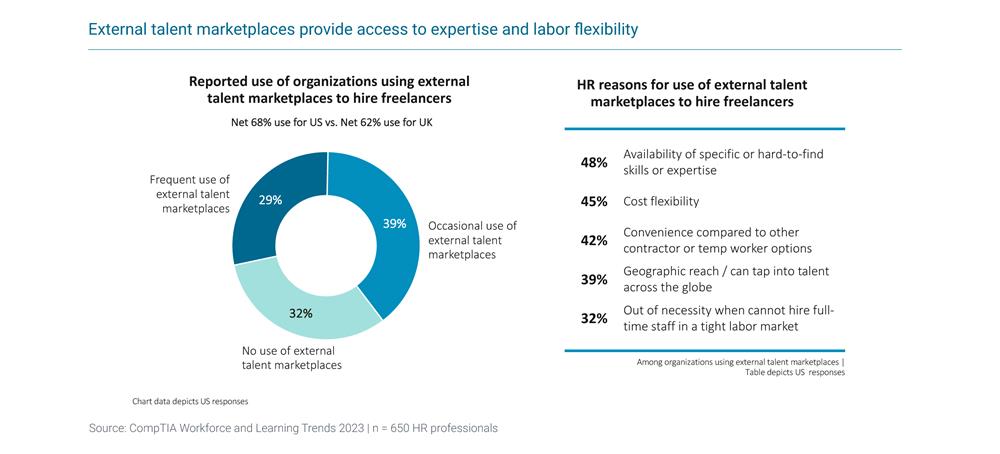
As the value of these platforms has become more evident and the tools themselves have become more powerful, companies have begun to develop their own internal talent marketplaces. Notable early adopters include Unilever, Schneider Electric, Standard Charter, Seagate, Societe Generale, and IBM. These companies hope that their internal talent marketplaces will encourage employee engagement and improve retention by making career opportunities more visible and accessible to their workforce.
An internal talent marketplace can facilitate and streamline a wide range of an organization’s talent management needs; many combine aspects of career management, social networking, and a recruiting system in one. A talent marketplace can also provide access to gig work, mentorship, rotation programs, volunteer options, and skill-building experiences that support the organization’s strategic objectives.
As noted in the section covering the “Algorithms and Platforms Exert Greater Influence over Talent Development” trend, internal talent marketplaces are expected to increasingly leverage AI-enabled tools, empowering them to develop an organization-wide skills inventory, identify skills gaps, and dynamically match interested workers to new opportunities that they might not otherwise consider.
By improving transparency, talent marketplaces might also enhance DEIB efforts. Research shows that job candidates consistently decide not to apply for positions because they believe they will not be fairly or accurately evaluated. Even when they have the requisite skills, they suspect the person in charge of hiring will perceive them as unqualified. Women are especially reticent to apply for jobs unless they strictly meet all of the criteria set out in the job description. An AI-powered marketplace can foreground relevant opportunities to these workers, which can shift the candidates’ perceptions about their suitability for a role and how they will likely be evaluated. In addition, marketplaces can showcase employees’ skills, experiences, and potential, rather than their rank, so that hiring managers and team leaders can more easily identify potential alignment with projects and opportunities.
The trend towards talent marketplace platforms seems likely to accelerate. Gen Z and millennial workers are very comfortable with these tools, and they are also more likely to have engaged in the kinds of flexible work arrangements that are often procured through these platforms. In this year’s survey, 46% of Gen Z and Millennials indicated that they “frequently” engaged in freelance or gig work, and 67% of workers in these age groups reported doing so “occasionally.” These workers are primed to think of their work more flexibly—not as filling a specific role but as providing skills for a particular project for a defined period. This perspective can be especially beneficial in a time of continued volatility when rapid adaptation can provide a competitive edge.
Spotlights
Training spending increases, but so does training fatigue
Despite varying degrees of concern around economic uncertainty, half of HR professionals indicate that their organizations plan to increase spending on training in 2023, versus only 10% expecting a decrease in spending. This is in keeping with broader findings. In addition to spending more money on training, 59% of respondents expect that the time devoted to training and development will increase in the next year while only 10% believe it will decrease. For context, according to the Association for Talent Development’s 2022 State of the Industry report, organizations spent on average $1,280 per employee on workplace learning.
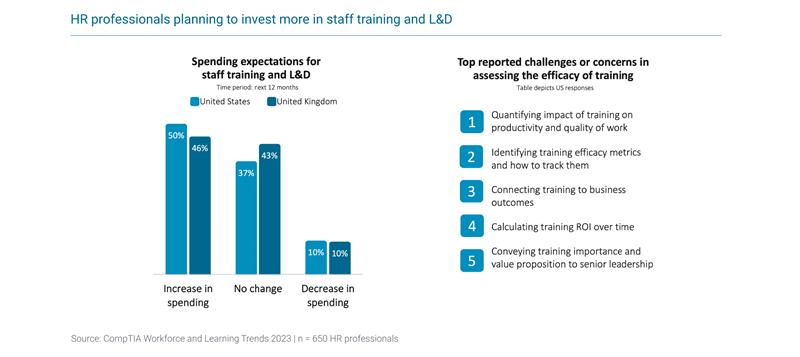
This year’s CompTIA survey found that 82% of HR professionals believe that training and development efforts help improve employee retention and engagement. However, worries about training fatigue have also increased. In our survey, 58% of HR professionals reported some degree of concern related to overtraining or training fatigue among their employees. This is unsurprising, given that the pandemic pushed workers to spend more time online and increased mandatory training and compliance requirements.
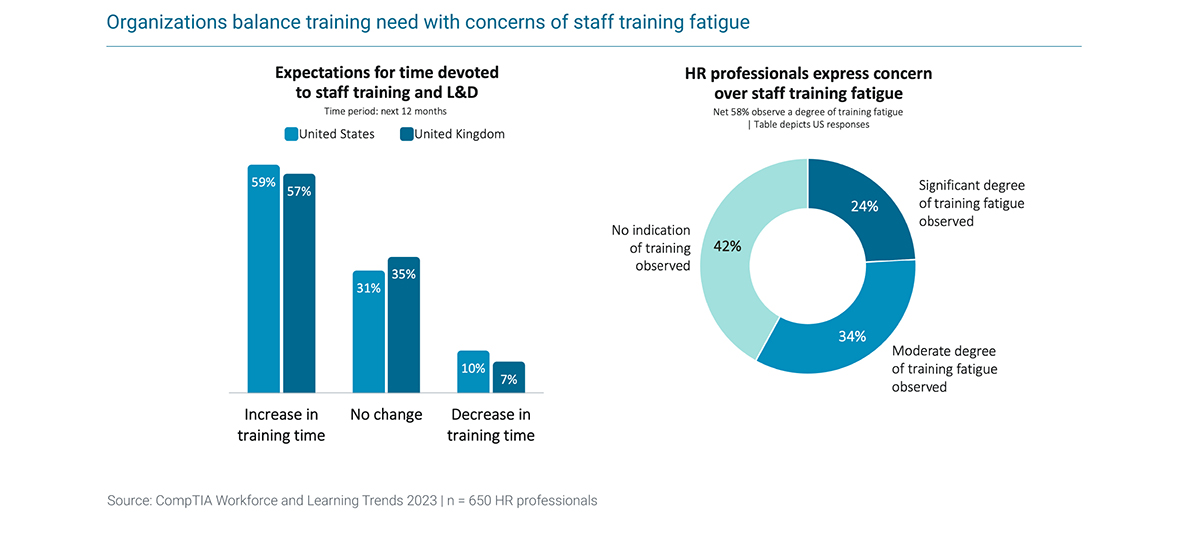
To counteract this fatigue, companies are refocusing their training programs to ensure they provide relevant and personalized opportunities that recognize individual achievement and skills acquisition, rather than pursuing a top-down model of training that promotes the organization’s needs. This has led to more of a “mix and match” approach to education, including an expansion of self-service formats, such as podcasts, webcasts, video conferences, and e-learning modules, as well as in-person activities that achieve multiple purposes, like instructor-led courses that also devote time to networking and informal mentoring. AI-powered training tools are also improving personalization options, enabling businesses to suggest customized training opportunities based on employee preferences — from content to format to when they participate. This gives employees more freedom to personalize their learning paths and develop new skills.
In light of the ever-increasing training demands, employers can no longer rely on workers’ sense of company duty or even their investment in a long-term career path to sufficiently motivate them to complete hours of online coursework. To address this issue, companies are focusing on shorter-term objectives and more immediate incentives, such as problem-based learning, rewards, badges, and gamification. An ample body of research demonstrates that such strategies increase learner engagement, attendance, participation, and feelings of competence.
Certifications add value to HR toolkit
Keeping up to date with the most in-demand and valuable skills is essential for employers and employees who want to remain competitive. To achieve this, employers want a hiring process that can efficiently and accurately identify candidates who possess the desired skills. Yet many HR professionals do not possess in-depth, technical knowledge of the skills their company is hiring for. Given the breakneck pace of innovation today, even experienced technology managers may find it difficult to identify and evaluate skills requirements. [Design note, brief callout referencing: For more on the topic of over-spec’ing in hiring and free tool to help overcome it, see the CompTIA Job Posting Optimizer]
The data confirms that industry-recognized technical certifications remain a powerful tool to verify a candidate’s knowledge, skills, and abilities (KSAs).
80% of HR professionals in medium-size and large organizations rely on industry-recognized technical certifications during the hiring process
Net among US HR professionals | Among UK HR professionals the net figure is 82%Although companies still value the knowledge gained from a four-year degree, they also recognize that higher education cannot keep pace with the constant evolution in technical skills. Certifications can provide more specific and concrete insights into an employee’s capabilities than a degree can, especially one that was earned years ago or in another field of study.

Despite their value, certifications are also causing confusion, especially given their recent proliferation. The IT industry in particular has been inundated with badges, designations, and other forms of credentialing that can make it very difficult to determine their significance. Smaller organizations often do not have an expert on their team who can validate the worthiness of a particular recognition. For these reasons, CompTIA advocates for industry-recognized certifications, which typically require formal coursework and a comprehensive exam. This ensures that the certification reflects not only the completion of a course, but also a necessary level of understanding.
Age bias in the workplace has many facets
As many companies continue to face challenges in attracting and retaining top talent, especially in specialized and hard-to-fill positions, there’s one segment of the workforce they may be overlooking—older workers.
The majority of HR professionals in the CompTIA survey indicated that their organization has not implemented a retention program that specifically targets aging employees or those nearing retirement. Only 14% report having a dedicated program or effort, while 32% report an “all of the above” approach in programs and efforts to retain workers.
This is a segment of the workforce that is eager to stay engaged, according to research. In its study, Voya Financial, a subsidiary of ING, used the term “employment extenders” to refer to workers over 50 who had retired but later rejoined the workforce. Some media outlets couldn’t resist referring to this as the “great unretiring,” as segments of workers returned to work after a temporary, pandemic-induced retirement.
Yet, according to an AARP survey, “78% of workers age 50 or older said they’ve seen or experienced age discrimination in the workplace.” Similar to other forms of bias, this may take many forms, from overt stereotypes of older workers being less tech-savvy to subtler forms of unconscious bias, such as assuming an older worker is less interested in learning new skills.

Age bias remains a concern in the tech workforce. Demographic data confirms that the tech workforce skews younger than the overall US workforce. There are many factors at play in age distributions across occupation categories, so the data does not automatically prove bias, but combined with other directional insights, it does suggest employers, managers, and perhaps older workers themselves are acting in ways counter to their interests.
According to World Economic Forum, older workers are looking for job security, work-life balance, unretirement (the desire to work), and belonging—not so different from employees in other generations. All in all, this cohort may represent key benefits to employers struggling to find talent.
The other facet of this discussion occurs at the other end of the age and bias spectrum. That is what may be characterized as the “positivity bias” of assuming younger age cohorts – the Digital Natives—are experts in workplace technologies. This very issue was raised in the recent article, “Gen Z Has a Tech Skills Gap at Work,” which detailed the challenges that younger workers face as they transition from consumer-friendly apps and videogames to enterprise-level networks, applications, and security requirements.
Despite the questionable practice of grouping large swaths of the population into classifications based on birth year and then assigning labels to them, the reality is that generational cohort discussions will never disappear from workplace discourse. Savvy organizations will look past labels and bias and instead focus on recruiting, retaining, and developing the best possible team they can.
Buzzword Watch
By design, buzzwords elicit a reaction. Sometimes the reaction is an eyeroll in response to the unnecessary labeling of everything that then snowballs out of control due to keyword tagging and SEO. In other situations, it may be a shoulder shrug of confusion at insider jargon or the repackaging of longstanding concepts with new terminology. Putting aside these minor amusements – or annoyances, depending on your perspective—buzzwords do often provide some new kernel of insight into how workers or organizations are thinking and behaving.
Buzzwords and terms making the rounds in news stories and social media references include:
- Anti-perks
- Career cushioning
- Ghost jobs / Ghosting
- Hustle culture
- Labor hoarding
- Micro-stresses
- Permacrisis
- Productivity paranoia
- Proximity bias
- Quiet hiring
- Rage applying
- Surge staffing
For further reading, see articles such as 23 trending HR buzzwords.
Methodology
The CompTIA Workforce and Learning Trends study incorporates subject matter expertise from CompTIA’s team of world-renowned learning, development and research professionals. The quantitative component of the study consists of an online survey completed by 450 US HR and L&D professionals, and by 200 UK HR and L&D professionals. The complete dataset totals 650, yielding an approximated margin of sampling error at 95% confidence of +/- 3.9 percentage points. Sampling error is larger for subgroups of the data. Data was collected during mid-January to mid-February 2023.
As with any survey, sampling error is only one source of possible error. While non-sampling error cannot be accurately calculated, precautionary steps were taken in all phases of the survey design, collection and processing of the data to minimize its influence.
CompTIA is a member of the market research industry’s Insights Association and adheres to its internationally respected Code of Standards. Please direct any questions about the content of this report to [email protected].
About CompTIA
The Computing Technology Industry Association (CompTIA) is the world’s leading information technology (IT) certification and training body. CompTIA is a mission-driven organization committed to unlocking the potential of every student, career changer
or professional seeking to begin or advance in a technology career. To learn more about CompTIA:
CompTIA Learning and Training
CompTIA Solutions Catalog
CompTIA Job Posting Optimizer
CompTIA IT Salary Calculator
CompTIA Tech Career Academy
CompTIA Spark
Read more about IT Workforce.

 Download Full PDF
Download Full PDF